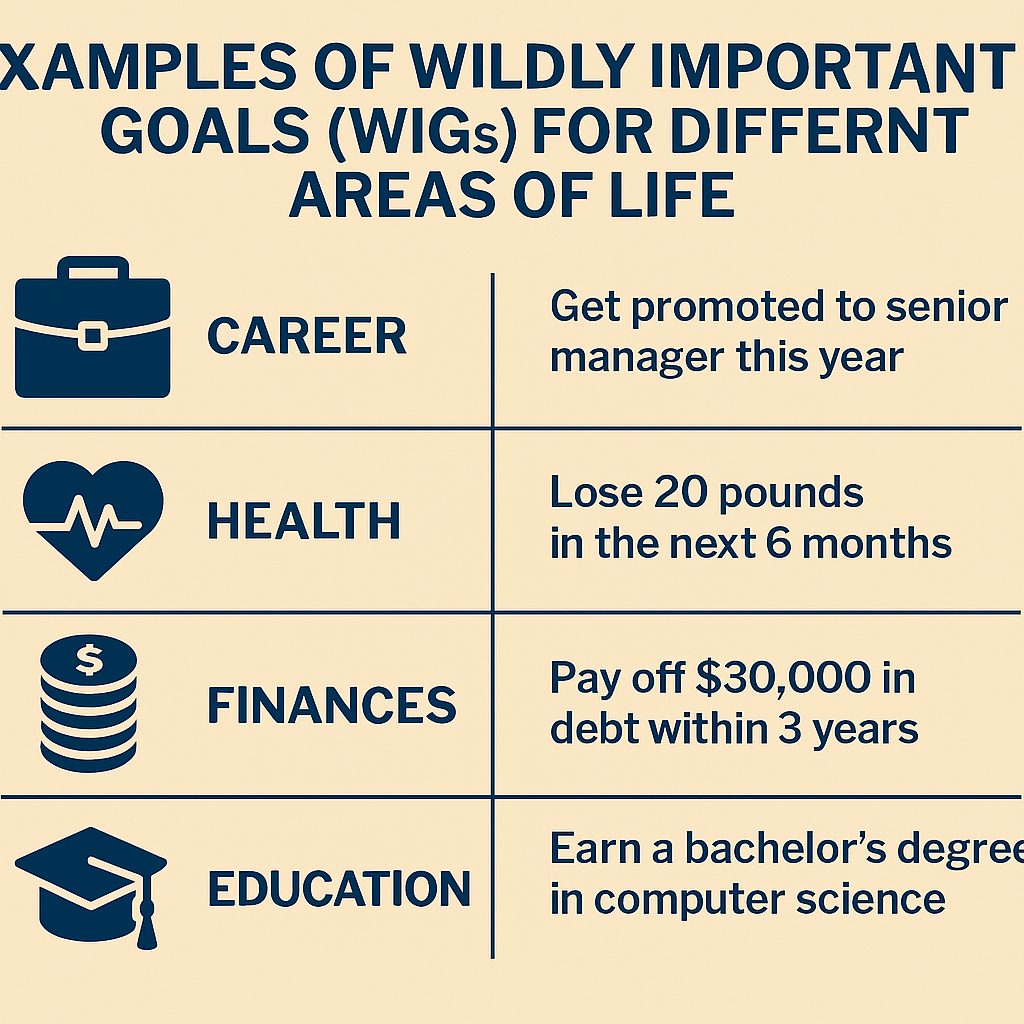Choosing the right Wildly Important Goal (WIG) is the cornerstone of successful execution using the 4 Disciplines of Execution (4DX). A well-crafted WIG brings clarity, direction, and measurable purpose—but what makes a good WIG? And how do you choose the right one for your life or work?
In this article, you’ll discover practical examples of WIGs across different areas: personal, professional, health, finance, and more. Use these as inspiration to define your own focused and strategic goals.
What Makes a Good WIG?
A Wildly Important Goal should be:
- Strategic: It creates significant impact
- Specific and Measurable: Not vague or open-ended
- Time-bound: Has a deadline
- Challenging but Achievable: It stretches you, but it’s realistic
Formula to follow:
“From X to Y by [date]”
WIG Examples for Personal Development
- “Read 12 books by December 31”
- “Wake up at 6:00 a.m. every weekday for 90 days”
- “Practice meditation for 10 minutes/day for the next 60 days”
- “Reduce weekly screen time from 30 hours to 15 by August 15”
These WIGs help build self-discipline and growth habits.
WIG Examples for Health and Fitness
- “Lose 5kg in 8 weeks through diet and exercise”
- “Exercise at least 4 times/week for the next 3 months”
- “Run a 10K race by October 10”
- “Increase daily water intake from 1 liter to 2.5 liters by next month”
Health WIGs are great when paired with specific lead measures like meal tracking or workout sessions.
WIG Examples for Career and Productivity
- “Write and publish 10 blog posts in the next 60 days”
- “Increase LinkedIn connections from 500 to 1,000 by September 1”
- “Complete 3 professional development courses by November 30”
- “Improve task completion rate from 70% to 90% by tracking daily habits”
Make sure your WIG aligns with your long-term career vision.
WIG Examples for Business and Freelancing
- “Grow client revenue from $3,000/month to $6,000/month by Q4”
- “Launch an online course with 100 students by October 15”
- “Get 10 new customer reviews in the next 30 days”
- “Increase email open rate from 15% to 25% in 60 days”
These are excellent for entrepreneurs looking to scale with purpose.
WIG Examples for Financial Goals
- “Save $5,000 for a house down payment by December 31”
- “Pay off $2,000 of credit card debt in 90 days”
- “Cut monthly expenses from $3,000 to $2,500 by next quarter”
- “Build an emergency fund of $1,000 in 60 days”
Pair these with habits like budgeting and automatic transfers for best results.
WIG Examples for Relationships and Family
- “Plan and complete 8 weekly date nights with my partner by September”
- “Call my parents 3x/week for the next 2 months”
- “Spend 1 hour of distraction-free time daily with my kids for 30 days”
- “Organize and complete a family vacation by August 15”
These WIGs help create intentional, meaningful connections.
WIG Examples for Teams and Organizations
- “Reduce support ticket resolution time from 24 to 6 hours by Q3”
- “Increase team project completion rate from 70% to 90% by November”
- “Complete onboarding for all new hires within 10 days by next quarter”
- “Grow internal satisfaction score from 7.2 to 8.5 by year-end”
These goals are especially effective when everyone contributes to lead measures.
Tips for Choosing Your Own WIG
- Don’t overthink—choose what will matter most 3 months from now
- Limit yourself to one WIG per area of life or work
- Use a scoreboard to track progress weekly
- Pair each WIG with 1–2 lead measures
- Share your WIG with someone who can support your progress
Final Thought: Start With One Goal That Moves Everything Else
You can’t improve everything at once—but you can improve the one thing that matters most right now. That’s the power of a well-defined WIG.
Review these examples. Pick one that resonates. Make it specific. Give it a deadline. And start executing with intention using the 4DX method.
